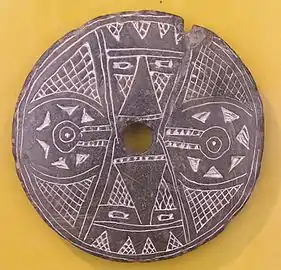Spindle whorl
A spindle whorl is a weighted object fitted to a spindle to help maintain the spindle's speed of rotation while spinning yarn. It typically takes the form of a disk or spherical object, sometimes whorled, normally positioned on the bottom of the spindle. The spinner spins the resulting weighted spindle up to speed, which the whorl maintains, and then slowly pulls the fabric off a mass of fibers which the spindle then twists into yarn.

Spinning with a whorl (c) on a spindle (b) and distaff (a) (above)
Historically, whorls have been made of materials like amber, antler, bone, ceramic, coral, glass, stone, metal (iron, lead, lead alloy), and wood (oak). Local sourced materials have been also used, such as chalk, limestone, mudstone, sandstone, slate, lydite and soapstone.
Gallery
%252C_19th_century%252C_05.588.7382.jpg.webp) Spindle Whorl (Sulsultin), Chemainus, Coast Salish (Native American), 19th century, Brooklyn Museum
Spindle Whorl (Sulsultin), Chemainus, Coast Salish (Native American), 19th century, Brooklyn Museum Whorl (12th or 13th century) found in Poland
Whorl (12th or 13th century) found in Poland Ancient Greek spindle whorls, 10th century BC, Kerameikos Archaeological Museum, Athens
Ancient Greek spindle whorls, 10th century BC, Kerameikos Archaeological Museum, Athens Muisca spindle whorl (500AD – 1500AD). Archaeology Museum, Sogamoso, Colombia
Muisca spindle whorl (500AD – 1500AD). Archaeology Museum, Sogamoso, Colombia.jpg.webp)
This article is issued from Wikipedia. The text is licensed under Creative Commons - Attribution - Sharealike. Additional terms may apply for the media files.